Zaandam (III)
A history of Zaandam's and dykes
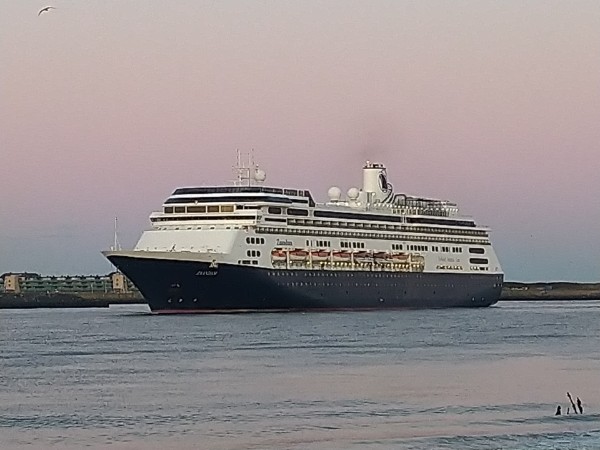
Above, Zaandam is seen sailing into IJmuiden port as she arrives in The Netherlands for the first time in het lifetime at the 15th of may in 2020. She comes in after a repositioningvoyage across the Atlantic to take on supplies and water and to lift some crewmembers off to get home. This all due to the outbreak of the COVID-19 pandemic, grinding all cruiseservices in the world to a halt. Later that same day, she was again leaving port for anchorange just outside the Dutch town of Scheveningen, where she also met her newer 100.000-ton fleetmate Nieuw Statendam.
The name Zaandam was first used in 1882 for one of the new and larger steamers of the new NASM (Netherlands American Steam & Navigation Co.), that sailed a transatlantic steamservice between Rotterdam in The Netherlands to New York. After the opening of the New Waterway between the Dutch port and the sea in 1872 the company had grown considerable throughout the quite difficult 1870's into the more profitable 1880's and the need for larger ships arose. When Zaandam entered service, she was the largest ship within the HAL-fleet as the first one measuring more then 3000 tons (3063 to be precise). She sailed for the company untill 1897, replaced by the thirth Rotterdam of over 8000 tons. A second Zaandam took a while, as she was only introduced in 1938 as a close to 11.000-ton combinationliner for 160 passengers and freight. She didn't have a long carreer as she was requisitioned by the US in march 1942 as an armed merchant cruiser, sadly already torpedoed by the U174 on a voyage between Cape Town and New York the following november. Out of 299 people aboard at that time, 175 survived. Three of those survivers were picked up by a US navy patrolvessel more then 2000 miles from the spot where Zaandam had foundered after they had been surviving at a raft for 83 days. This still is counted as the longest time people have survived at sea in such conditions so that fact takes the Zaandam name into the maritime records.
Next to the passenger- and combinationfleet with names ending at -dam, Holland America Line as they were later known, operated a pure freightfleet with names ending at -dijk. Under the name of Zaandijk, also two ships had been in service. The first Zaandijk sailed from 1909 untill 1917 and measured some 4189 tons. The second Zaandijk of 4518 tons sailed between 1918 and 1923.
Background
After Carnival Cruise Lines took over Holland America Line in 1988, they ordered a new class of four ships to strenghten the position of the old line in the new world order of modern cruising. Holland America had just before ordered a class of three 60.000-ton cruiseliners whose names were all planned to be starting with the letter 'S' so dubbed the 'S'-class. With a capacity of just 600 passengers, Carnival estimated that they would not be able to attract the profits needed to keep the line afloat. That's why the original order was cancelled and replaced by the order for a new, slightly smaller class of 56.000-ton cruiseliners with a capacity of 1500 passengers. This class of four, Statendam (1993), Maasdam (1993), Ryndam (1994) and Veendam (1996) is nowadays still referred to under the intended name of the 'S'-class, mainly because the name of the first ship was also the name of the first ship of the originally planned trio, Statendam. These ships doubled the line's capacity in the early 1990's and joined the classic fleet of the 1959-built ex-liner Rotterdam, the 1980's duo of splendid Noordam (1982) and Nieuw Amsterdam (1983) and the Westerdam (1986), a ship originally built for Home Lines before that company was bought by Holland America just before the merger into Carnival. Being modern cruiseships, the new class of four were dramaticly different from the older ships, but still retained the classic oceanliner feel to them so appreciated by the older clientele of Holland America Line.
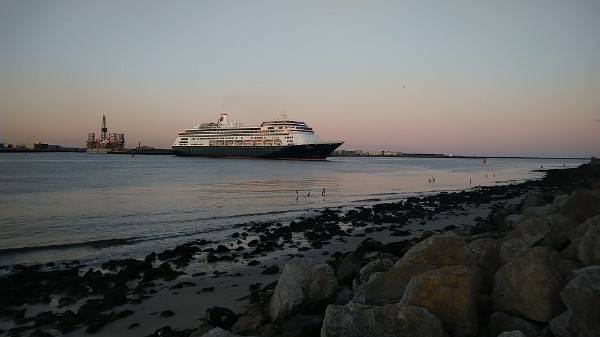
It also became clear that this new design was outdating the older ships, although they are still loved by the classic HAL passengers and the rest of the world too actually, as the grey lady Rotterdam even was named the Cruiseship Of The Year in 1996! But to bring the old line into the new century, a new order was placed during the early 1990's for a new flagship, replacing this greatly loved oceanliner, yet under the same name. This sixth Rotterdam of 60.000-tons, so slightly larger then the 'S'-class, was introduced in 1997 and although a lot of HAL fanatics would kill to bring the fifth Rotterdam back into HAL service now, the new flagship was also gaining reputation and a great following over the years. She retained many classic and stylish elements, by no means recognizable as a ship owned by Carnival, and she was even designed by the house-designer of Holland America, the Dutch firm VFD from Utrecht. In all she was a classic and Dutch HAL liner and she did adopt quickly to both old and new customers. Not strange, she would recieve a few sisters of her own over the last years of that same decade while the rest of the older fleet was silently going out through the backdoor.
As none of the previous five Rotterdam's ever had sisterships, it was hoped to have only one of her too. But economicly, the times had become very different and this was by no means viable. But to retain some of her originality, the two following sisters recieved quite a different look to them, as they did not sport the dual funnel that made the sixth Rotterdam so recognizable. She of course had inherited this feature from her older namesake and it was fitting that the next two ships in line were not built to the same profile. Slightly bigger and with just one chunky funnel, the new ships were very similar in appearance to the 'S'-class and they came into the fleet under the names of Volendam in 1999 and Zaandam in the year 2000. A fourth unit of the class recieved the name of Amsterdam but like the Rotterdam, she did recieve the dual-funnel look. This as she was going to be the line's second flagship. Also for a technical reason, as her aftdecks were higher then her sisters so this design would deflect more particles from her upper decks then with the standard design.
Construction and general statistics
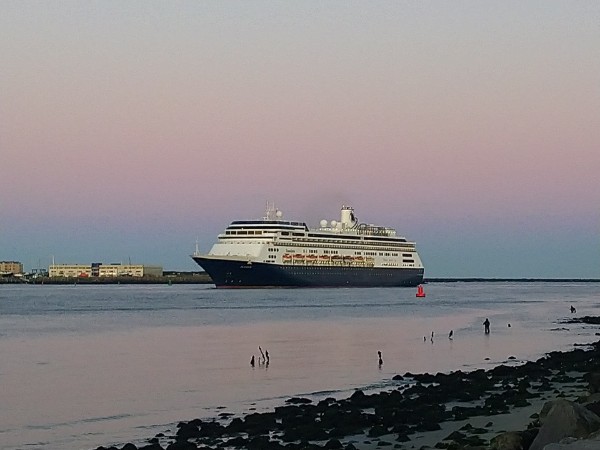
Yardnumber 6036 was built at the Fincantieri Yards in Marghera, Italy and her keel was laid, at the 26th of june in 1998. She was going to measure 60.906 tons, making her the largest cruiseship untill then in the Holland America Line fleet, together with her sister Volendam of equal size. She had a lenght of 237 meters, a width of 32,28 meters and a draft of 8,10 meters. The ship has ten decks and a capacity for 1432 passengers, although the maximum count is set on 1846. Also, to serve all those holidaymakers, some 647 crewmembers take care of them. She is driven by five 12-cylinder diesel engines designed by Sulzer-Fincantieri making it possible to sail her services at a speed around 23 knots. Also, five generators connected to electric motors provide her power. Driven traditionally by two screws, the ship was designed too early for modernities like pods. The ship flies the Dutch flag, homeported in Rotterdam.
Zaandam floated out on the 30th of april in 1999, co-incidently on a Queensday, a Dutch holiday celebrating the Royal Family. She then moved to the fitting out quay so she could be finished and delivered on time to her owners at the 8th of april the following year.
Design
Music is the central theme for the ship and she has, as a HAL tradition, many memorabilia onboard. You can find signed guitars from the Rolling Stones, Iggy Pop, Eric Clapton Carlos Santana and Queen aboard, next to a saxophone played by former US president Bill Clinton, which he signed on the mouthpiece and is now on display in the ships' main stairwell. Also a traditional baroque Dutch pipe-organ is the central focus in the ships' atrium, so many musical styles are honoured.
The ship is very traditional with many darker woods like the old oceanliners, and she also had a real teak wraparound promenade deck so loved by the HAL clientele. Many traditional HAL spaces are also returning from the 'S-class and earlier vessels, like the Crow's Nest which is a 270 degrees lookout at the ships' topdeck, the traditional Rotterdam Dining Room in which you can dine in the oceanliner style, so bring your best tux and gowns as otherwise you will be looked at as being Jack Dawson lost in the wrong class. The Lido Restaurant is the less formal alternative, but also here dress appropriately as you would in a normal shoreside restaurant. Another place to dine is the more exclusive Pinnacle Grill or the Italian Caneletto's, a part of the Lido Restaurant. Both last places need to be reserved for a small fee.
In the Culinary Arts Center cookingclasses are organized and there is the extensive onboard library and internet café/ coffeeplace named the Explorations Café, which is sponsored by the New York Times. This also is one of the best relaxed places aboard to get a morning coffee and read your favorite newspaper. Then there is the Mondriaan Show Lounge, providing evening entertainment. Although the company provides a good variation of shows in the Mondriaan Showlounge in a number of genre's, the tone is quite mellow so no big Broadway styles or close to naked young ladies dancing.
Although traditional and not the first choice maybe for families with young children, there are several childrens' programs and they will be kept busy in a very friendly Dutch hospitality. The Club HAL offers a highly regarded and looked-after possibility to take your children along, while having a very relaxing and close to semi-luxury experience yourself. Do mind that not many young children are travelling aboard the ships so especially in more quiet times it can be hard for youngsters to make new friends aboard.
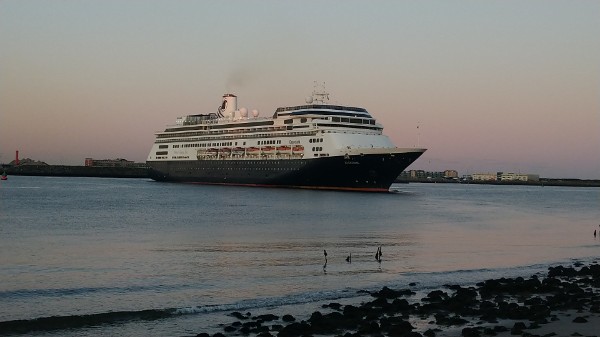
Carreer
Named in Fort Lauderdale, Florida by Marie-Kate and Ashley Olson on the 5th of may 2000, again co-incidently on the Dutch holiday on which we celebrate our liberation from the German forces after the second world war, the ship settled in for her Caribbean cruiseservices starting with her Maiden Voyage at the 6th of june.
The ship is totally dedicated to the American market, sailing summercruises in Canada and New England and wintercruises around Hawaii and Mexico. Also, she is seen in between those cruising around South America and the Antarctic. In her now 20 years carreer for the line, the ship hasn't seen many interruptions, only an outbreak of Norovirus in 1998 on a voyage from Seattle to Alaska in that june affected 73 persons.
In 2020 however, the whole world came into the grip of the COVID-19 pandemic, one of the worst diseases in history able to grind the whole cruise-industry to a halt. Also Zaandam was affected on a voyage departing Buenos Aires, Argentina which departed on that 7th of march. On the 14th of march, close to the coast of Chili, some 13 passengers and 100 crewmembers had fallen ill and Chili denied them access. She was diverted to Fort Lauderdale, but also the Panama Canal denied entry for the ship, on which now 77 persons were diagnozed with COVID-19. Additional medical supplies and medical crew came over from the nearby Rotterdam and several healthy passengers were also transferred to this ship. Sadly, awaiting transit through the canal, four passengers passed away and the number of sick persons aboard rose steadily to 193. On the 28th of march, clearance was given to pass the canal for both ships, sailing in tandem. But later again they were denied to dock in Fort Lauderdale by the mayor and even by the state governor before the right measures had been taken. Instead, the governor insisted that medical care would be flown out to the ship instead.
On the first of april, US president Trump mentioned that the people on the ship had to be helped and finally the ships were able to dock and the sick could be transferred to local hospitals while the healthy could be flown home. The crew still was to remain onboard and were not allowed to leave the ship.
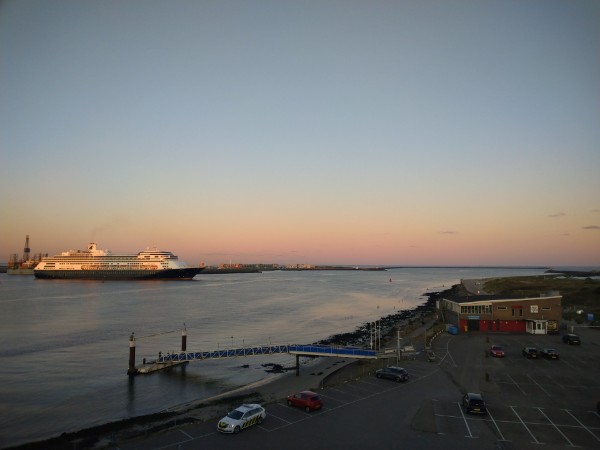
The ship left Port Everglades for Europe on the 28th of april, 2020 firstly planned for Rotterdam but finally arriving in IJmuiden at the 15th of may after some days anchoring outside the port. She came into IJmuiden for bunkering and unloading some crew, before eading back to sea that same day, anchoring in front of Scheveningen together with her larger fleetmate Nieuw Statendam. Both ships then started the waiting game for renewed cruiseservice.

